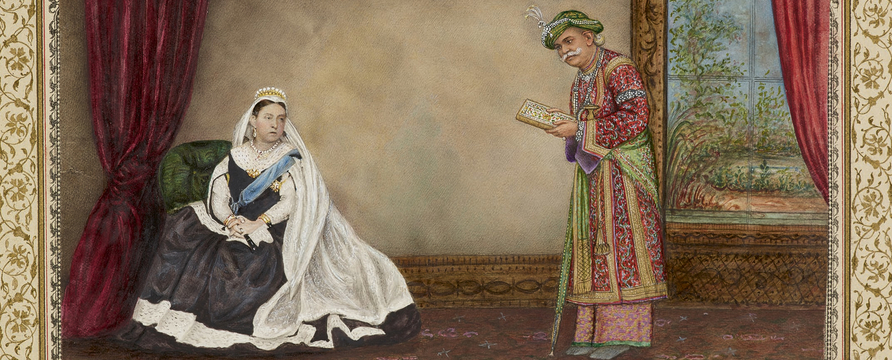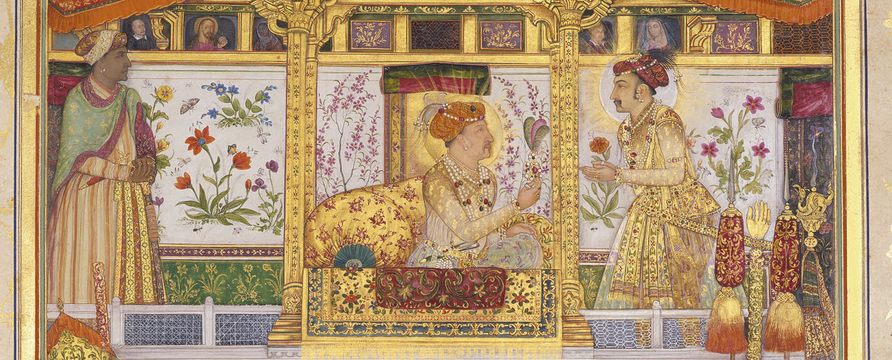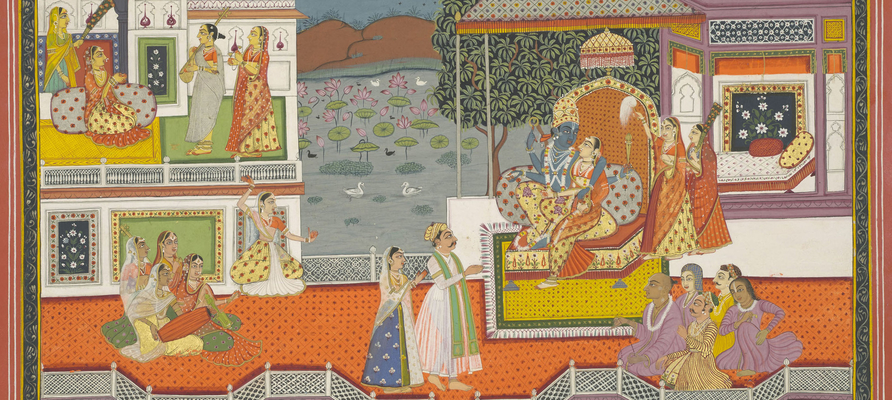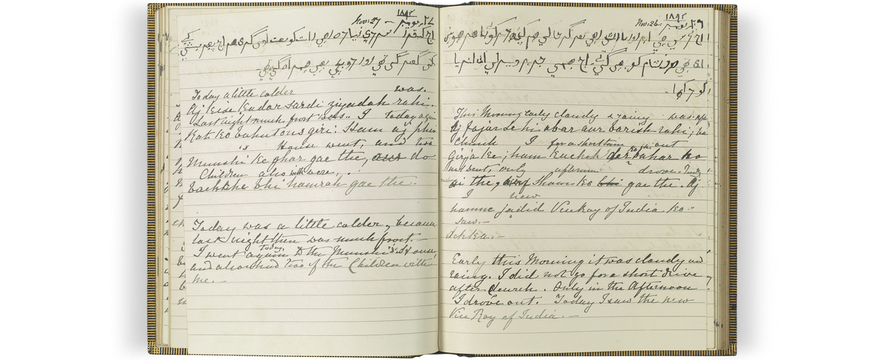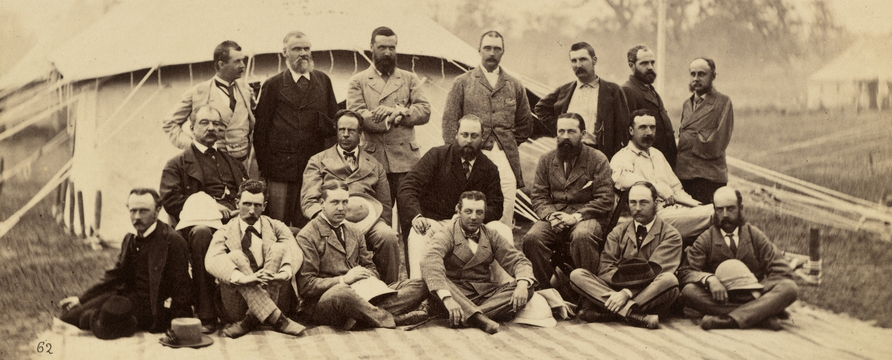Varanasi artist, Painted frontispiece of The Queen’ s Travels in Scotland and Ireland /© Her Majesty Queen Elizabeth II 2020
Highlights from the South Asian holdings of the Royal Collection will be on display from 3 April–13 September 2020 for the first time in Scotland, at The Queen’s Gallery, Palace of Holyroodhouse as part of Eastern Encounters: Four Centuries of Paintings and Manuscripts from the Indian Subcontinent. Paintings, prints, drawings and photographs from the wider Royal Collection included in the exhibition will explore the 400-year shared history of the British monarchy and the rulers of South Asia.
The Royal Collection contains one of the finest groups of South Asian paintings and manuscripts in the world, which are also held in the Royal Library at Windsor Castle. Featuring outstanding examples of the literary and artistic output of the area historically called India, now covered by India, Pakistan and Bangladesh, the collection includes exquisite illuminated manuscripts, vivid depictions of the Mughal court, royal portraits, architectural studies and vibrant illustrations of Hindu epics.
The establishment of trade routes to South Asia and the formation of the East India Company, sanctioned by Elizabeth I in 1600, opened up the glories of the subcontinent to Britain. While the 17th century was a period of instability for the British monarchy, in South Asia the Mughal dynasty celebrated a glorious Golden Age. Richer and stronger than any European power, at its height the Mughal Empire ruled over more than 150 million subjects and extended across most of the Indian subcontinent.
Payag, Painting from the Padshahnama manuscript (‘Book of Emperors’), c.1630-55 /© Her Majesty Queen Elizabeth II 2020
The extraordinary splendour of the Mughal court was captured by artists in intricate paintings and manuscripts. George III was given a number of these magnificent works, forming one of the greatest collections of South Asian works on paper outside the subcontinent. In 1798, Lord Teignmouth, Governor-General of India presented the King with six volumes as gifts from the Nawab of Awadh. Among these was the mid-17th-century Padshahnama (Book of Emperors), an illustrated chronicle commissioned by the fifth Mughal Emperor Shah-Jahan as a celebration of his reign and dynasty, described by Teignmouth as ‘the most splendid’ Mughal manuscript he ever saw.
Jaipur artist, Painting from a series of the Gita Govinda, Vishnu and Lakshmi enthroned, c.1800 /© Her Majesty Queen Elizabeth II 2020
The rise of the East India Company was also reflected in the gifts of manuscripts presented to successive British monarchs on behalf of the Company and by Company officers. Such works include a Quran owned by Tipu Sultan of Mysore with an illuminated frontispiece and gilt-stamped and painted bindings, presented to George III. Detailed architectural drawings were commissioned from local draughtsmen by Colin MacKenzie, the Scottish Surveyor-General of the Company. A pen and ink drawing, c.1800, shows a plan of the temple at Srirangam, one of the most important pilgrimage sites in India.
Following her accession in 1837, Queen Victoria received many illuminated royal letters and gifts of paintings and manuscripts from South Asia. A posthumous portrait of Maharajah Ranjit Singh, the Sikh ruler of the Punjab, c,1842, was sent to the Queen by his successor, Sher Singh, in an unusual jewel-encrusted gold frame with a letter of belated congratulations on her marriage and the birth of her first son. It will be displayed alongside a sketch of his son, Maharaja Duleep Singh, by Queen Victoria. Following the East India Company’s annexation of the Punjab in 1849, Duleep Singh moved to England where he became a favourite of the Queen, regularly visiting Osborne House and Windsor Castle.
Queen Victoria’s Hindustani diaries, November 1893 to March 1894 /© Her Majesty Queen Elizabeth II 2020
Queen Victoria received many books written about or dedicated to her from India, including a volume of her own published journals, The Queen’s Travels in Scotland and Ireland, translated into Hindi by the Maharajah of Benares. The Queen recorded the book’s arrival in England: ‘My book, translated into Hindustani, beautifully illuminated, containing a painting of me, by a native artist, receiving the present from the Maharajah of Benares, bound in inlaid marble, is very curious and really beautiful.’ Victoria’s interest in South Asian culture continued throughout her life. Her studies of the Hindustani language, undertaken in her seventies with her Indian secretary Abdul Karim, are recorded in her Hindustani phrasebook.
Queen Victoria’s second son Alfred, Duke of Edinburgh was the first member of the royal family to visit India in 1869, followed six years later by Albert Edward, Prince of Wales (later King Edward VII), who toured India for four months in 1875–76. This second trip acted as a precursor to the formal declaration of Queen Victoria as Empress of India in 1876. During his tour, the Prince was presented with several works of art from the Hindu courts of northern India including a series of vibrant paintings from Jaipur that reproduced verses from the Sanskrit devotional poem Gita Govinda (‘Song of the Cowherd’).
Shepherd, Photograph of Albert Edward, Prince of Wales, later King Edward VII during his tour of India in 1875 /© Her Majesty Queen Elizabeth II 2020
Although King Edward VII never returned to India, he sent his brother and later his son, the future King George V, on royal tours of South Asia. Both the Prince of Wales and his wife, Princess Mary of Teck, fell in love with ‘dear beautiful India’, and, following their initial visit in 1905–6, returned to the subcontinent as Emperor and Empress for a Coronation Tour in 1911–12, the first time that a reigning British monarch had set foot on Indian soil. Their tour was documented in photographs and souvenir books, including albums and scrapbooks compiled by Queen Mary herself in addition to individual photographs mounted together to form a panorama of key moments of the 1911 Durbar, an imperial assemblage, including when King George V formally proclaimed himself Emperor of India.
Queen Mary noted in her diary from the tour of the subcontinent that she ‘was particularly interested in the exquisite drawings by native artists’. She acquired numerous South Asian works of art, including Queen Tissarakshita, 1911, by Abanindranath Tagore, founder of the Bengal School of Art, and several Pahari paintings, including 16 folios illustrating The story of Prahlada from the Bhagavata Purana, c.1775–90, by the Nainsukh family workshop
After the death of King George V in 1936, Queen Mary presented a number of her South Asian works of art to the Victoria and Albert Museum and a selection of her Indian books, photographs and archival material to the India Office Library. Many of the finest pieces in her collection remained in the Royal Library, part of a collection of books, manuscripts and paintings spanning a period of over 400 years and representing the great artistic traditions of the subcontinent.
For more information about the Eastern Encounters: Four Centuries of Paintings and Manuscripts exhibition, please visit Royal Collection Trust’s website.



